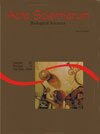<b>Flowering phenology and fruit set of native species of the Campos ecosystem</b> - DOI: 10.4025/actascibiolsci.v29i3.478
Abstract
The aim of this work is to study the phenology of twelve species that occur in “Campos” ecosystem in Paraná state. This research was carried out at the Universidade Federal do Paraná, Campus III, in Curitiba city. The selected species for phenologic evaluation were: Aspilia montevidensis (Sprengel) Kuntze, Cacalia cognata (Less.) Kuntze, Campovassouria bupleurifolia (DC.) R. M. King & H. Rob., Campuloclinium macrocephalum (Less.) DC., Chromolaena ascendens (Sch. Bip. ex. Baker) R. M. King & H. Rob., Lessingianthus glabratus (Less.) H. Rob. (Asteraceae), Eryngium sanguisorba Cham. & Schtdl. (Apiaceae), Moritzia dusenii Johnston (Boraginaceae), Petunia linoidesSendtn. (Solanaceae), Senna neglecta (Vogel) H. S. Irwin & Barneby (Fabaceae), Tibouchina gracilis (Bonpl.) Cogn. (Melastomataceae) and Verbena rigida Spreng (Verbenaceae). The applied methodology was the qualitative evaluation of the phenological data (florescence and fruiting) observed every fifteen days during the year 2004. The climatic variables as temperature, relative air humidity, precipitation and photoperiod were obtained daily to verify its relation with the phenophasis. The results showed that from all studied species, six of them presented reproductive phenology between January and August, while the others just had an interruption in the reproductive period during winter, except Aspilia montevidensis, which presented florescence and fruiting throughout the year.Downloads
Download data is not yet available.
Published
2007-12-05
How to Cite
Biondi, D., Leal, L., & Batista, A. C. (2007). <b>Flowering phenology and fruit set of native species of the Campos ecosystem</b> - DOI: 10.4025/actascibiolsci.v29i3.478. Acta Scientiarum. Biological Sciences, 29(3), 269-276. https://doi.org/10.4025/actascibiolsci.v29i3.478
Issue
Section
Botany
DECLARATION OF ORIGINALITY AND COPYRIGHTS
I Declare that current article is original and has not been submitted for publication, in part or in whole, to any other national or international journal.
The copyrights belong exclusively to the authors. Published content is licensed under Creative Commons Attribution 4.0 (CC BY 4.0) guidelines, which allows sharing (copy and distribution of the material in any medium or format) and adaptation (remix, transform, and build upon the material) for any purpose, even commercially, under the terms of attribution.
Read this link for further information on how to use CC BY 4.0 properly.
0.6
2019CiteScore
31st percentile
Powered by 

0.6
2019CiteScore
31st percentile
Powered by 











1.png)




3.png)













